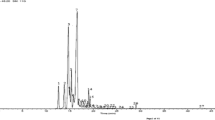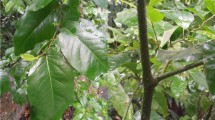Abstract
Blumea densiflora, an edible and medicinal plant, is chiefly distributed in Southeast Asia and South Asia. Essential oils extracted by steam distillation from B. densiflora were investigated for their chemical composition and larvicidal activity against Anopheles anthropophagus, the primary vector of malaria in China and other East Asian countries. Totally, 46 compounds were identified by gas chromatography and mass spectroscopy. The major chemical compounds identified were borneol (11.43%), germacrene D (8.66%), β-caryophyllene (6.68%), γ-terpinene (4.35%), sabinene (4.34%), and β-bisabolene (4.24%). A series of concentrations of essential oil (that ranged from 6.25 to 150 ppm) were tested against A. anthropophagus fourth-instar larvae according to WHO recommendation. In general, larval mortality increased as concentration and exposure time increased, indicating a dose-dependent effect, and high insecticidal activity showed that 100% mortality occurred within 6 h at 150 ppm, 10 h at 100 ppm, 30 h at 50 ppm, and 30 h at 25 ppm essential oil concentration. The LC50 values were 22.32 (after 12 h) and 10.55 ppm (after 24 h), and the LC90 values were 54.04 (after 12 h) and 33.56 ppm (after 24 h). Pylarvex, the reference standard, had better larvicidal activity, causing 100% mortality within 2 h at 150 ppm and within 6 h at 6.25 ppm. The results clearly reveal that the essential oil of B. densiflora served as a potential, eco-friendly mosquito larvicide against the malarial vector mosquito A. anthropophagus.

Similar content being viewed by others
References
Ajaiyeoba EO, Sama W, Essien EE, Olayemi JO, Ekundayo O, Walker TM, Setzer WN (2008) Larvicidal activity of turmerone-rich essential oils of Curcuma longa leaf and rhizome from Nigeria on Anopheles gambiae. Pharm Biol 46:279–282
Amer A, Mehlhorn H (2006a) Larvicidal effects of various essential oils against Aedes, Anopheles, and Culex larvae (Diptera, Culicidae). Parasitol Res 99:466–472
Amer A, Mehlhorn H (2006b) Repellency effect of forty-one essential oils against Aedes, Anopheles, and Culex mosquitoes. Parasitol Res 99:478–490
Amer A, Mehlhorn H (2006c) The sensilla of Aedes and Anopheles mosquitoes and their importance in repellency. Parasitol Res 99:491–499
Bhuiyan MNI, Chowdhury JU, Begum J (2009) Chemical components in volatile oil from Blumea balsamifera (L.) DC. Bangladesh J Botany 38:107–109
Cheng SS, Huang CG, Chen YJ, Yu JJ, Chen WJ, Chang ST (2009) Chemical compositions and larvicidal activities of leaf essential oils from two eucalyptus species. Bioresour Technol 100(1):452–456
Conti B, Canale A, Bertoli A, Gozzini F, Pistelli L (2010) Essential oil composition and larvicidal activity of six Mediterranean aromatic plants against the mosquito Aedes albopictus (Diptera: Culicidae). Parasitol Res 107:1455–1461
Dharmagadda VSS, Naik SN, Mittal PK, Vasudevan P (2005) Larvicidal activity of Tagetes patula essential oil against three mosquito species. Bioresour Technol 96(11):1235–1240
Don-Pedro KN (1999) Investigation of single and joint fumigant insecticidal action of citrus peel oil components. Pestic Sci 46:79–84
Dung NX, Loi DT, Hung DT, Leclercq PA (1991) Chemical composition of the oil of Blumea lanceolaria (Roxb.) Druce from Vietnam. J Essent Oil Res 3:285–286
Govindarajan M (2010) Chemical composition and larvicidal activity of leaf essential oil from Clausena anisata (Willd.) Hook. f. ex Benth (Rutaceae) against three mosquito species. Asian Pac J Trop Med 3:874–877
Greenwood BM, Fidock DA, Kyle DE, Kappe SHI, Alonso PL, Collins FH, Duffy PE (2008) Malaria: progress, perils, and prospects for eradication. J Clin Invest 118:1266–1276
Gupta SC, Khanolkar UM, Koul O, Saxena BP (1977) Pyrethrin synergistic activity by the essential oils of a few Blumea species. Curr Sci 46:304–305
James AA (1992) Mosquito molecular genetics: the hands that feed bite back. Science 257(5066):37–38
Kiran SR, Bhavani K, Devi PS, Rao BRR, Reddy KJ (2006) Composition and larvicidal activity of leaves and stem essential oils of Chloroxylon swietenia DC against Aedes aegypti and Anopheles stephensi. Bioresour Technol 97(18):2481–2484
Koliopoulos G, Pitarokili D, Kioulos E, Michaelakis A, Tzakou O (2010) Chemical composition and larvicidal evaluation of Mentha, Salvia, and Melissa essential oils against the West Nile virus mosquito Culex pipiens. Parasitol Res 107:327–335
Laakso I, Seppanen-Laakso T, Hiltunen R, Ekundayo O (1989) Composition of the essential oil of Blumea lacera DC. (Asteraceae) leaves from Nigeria. Flavour Frag J 4:73–75
Liu CF (1990) Comparative studies on the role of Anopheles anthropophagus and Anopheles sinensis in malaria transmission in China. Chinese J Epidemiol 11(6):360–363
Medhi SM, Reza SDA, Mahnaz K, Reza AM, Abbas H, Fatemeh M, Hassan V (2010) Phytochemistry and larvicidal activity of Eucalyptus camaldulensis against malaria vector, Anopheles stephens. Asian Pac J Trop Med 3:841–845
Mwangi JW, Achola KJ, Lwande W, Hassanali A, Laurent R (1994) Constituents of the essential oil of Blumea brevipes (Oliv. & Hiern) Willd. Flavour Frag J 9:233–235
Nathan SS (2007) The use of Eucalyptus tereticornis Sm. (Myrtaceae) oil (leaf extract) as a natural larvicidal agent against the malaria vector Anopheles stephensi Liston (Diptera: Culicidae). Bioresour Technol 98(9):1856–1860
Okumu FO, Knols BGJ, Fillinger U (2007) Larvicidal effects of a neem (Azadirachta indica) oil formulation on the malaria vector Anopheles gambiae. Malar J 6:63
Owolabi MS, Lajideh L, Villanueva HE, Setzer WN (2010) Essential oil composition and insecticidal activity of Blumea perrottetiana growing in Southwestern Nigeria. Nat Prod Commun 3:1135–1138
Rajkumar S, Jebanesan A (2010) Chemical composition and larvicidal activity of leaf essential oil from Clausena dentata (Willd) M. Roam. (Rutaceae) against the chikungunya vector, Aedes aegypti Linn. (Diptera: Culicidae). J Asia-Pac Entomol 13:107–109
Rahuman AA, Venkatesan P (2008) Larvicidal efficacy of five cucurbitaceous plant leaf extracts against mosquito species. Parasitol Res 103:133–139
Rahuman AA, Venkatesan P, Gopalakrishnan G (2008) Mosquito larvicidal activity of oleic and linoleic acids isolated from Citrullus colocynthis (Linn.) Schrad. Parasitol Res 103:1383–1390
Redwane A, Lazrek HB, Bouallam S, Markouk M, Amarouch H, Jana M (2002) Larvicidal activity of extracts from Querus Lusitania var infectoria gals (oliv). J Ethno Pharmacol 79:261–263
Senthilkumar A, Venkatesalu V (2010) Chemical composition and larvicidal activity of the essential oil of Plectranthus amboinicus (Lour.) Spreng against Anopheles stephensi: a malarial vector mosquito. Parasitol Res 107:1275–1278
Senthilkumar A, Kannathasan K, Venkatesalu V (2008) Chemical constituents and larvicidal property of the essential oil of Blumea mollis (D. Don) Merr. against Culex quinquefasciatus. Parasitol Res 103:959–962
Tiwary M, Naik SN, Tewaryb DK, Mittalc PK, Yadavc S (2007) Chemical composition and larvicidal activities of the essential oil of Zanthoxylum armatum DC (Rutaceae) against three mosquito vectors. J Vector Borne Dis 44:198–204
Trabousli AF, El-Haj S, Tueni M, Taoubi K, Nader NA, Mrad A (2005) Repellency and toxicity of aromatic plant extracts against the mosquito Culex pipiens molestus (Diptera: Culicidae). Pest Manag Sci 6:597–604
Wattal BL, Joshi GC, Das M (1981) Role of agricultural insecticides in precipitating vector resistance. J Comm Dis 13:71–73
World Health Organisation (1981) Instruction for determining the susceptibility or resistance of mosquito larvae to insecticides. WHO, Geneva, pp 1–6
World Health Organisation (2010) World Malaria Report 2010. WHO, Geneva, pp 60–61
Acknowledgments
The authors are grateful for being financially supported by the National Natural Science Foundation of China (20676041).
Author information
Authors and Affiliations
Corresponding author
Rights and permissions
About this article
Cite this article
Zhu, L., Tian, Y. Chemical composition and larvicidal activity of Blumea densiflora essential oils against Anopheles anthropophagus: a malarial vector mosquito. Parasitol Res 109, 1417–1422 (2011). https://doi.org/10.1007/s00436-011-2388-2
Received:
Accepted:
Published:
Issue Date:
DOI: https://doi.org/10.1007/s00436-011-2388-2




